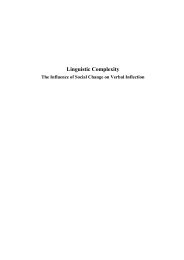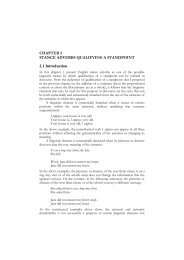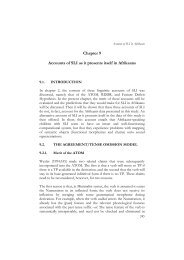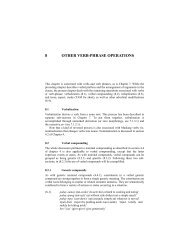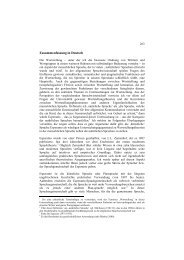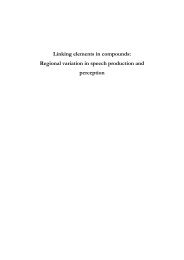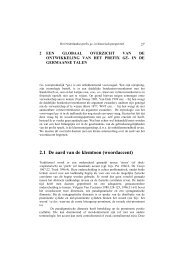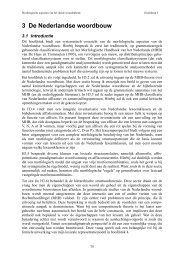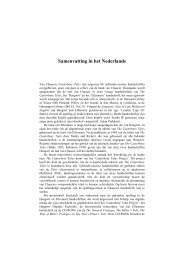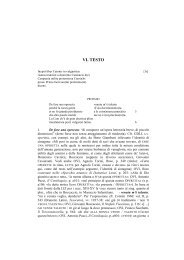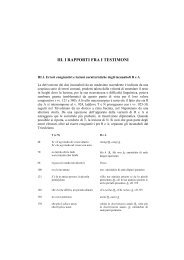Chapter 3 The Dutch Situation - LOT publications
Chapter 3 The Dutch Situation - LOT publications
Chapter 3 The Dutch Situation - LOT publications
Create successful ePaper yourself
Turn your PDF publications into a flip-book with our unique Google optimized e-Paper software.
<strong>The</strong> <strong>Dutch</strong> <strong>Situation</strong><br />
A slightly different solution is chosen in the Van Dale dictionary, which<br />
distinguishes as many as eight different groups of nouns (again, m. stands for<br />
mannelijk ‘masculine’ and v. for vrouwelijk ‘feminine’, while o. is short for onzijdig<br />
‘neuter’):<br />
– de; m (de-noun, masculine, e.g. berg ‘mountain’, chocolade ‘chocolate’)<br />
– de; v (de-noun, feminine, e.g. gevangenis ‘prison’, universiteit ‘university’)<br />
– de; m,v (de-noun, masculine or feminine, e.g. mens ‘human’, persoon<br />
‘person’)<br />
– de; v(m) (de-noun, feminine (or masculine), e.g. broek ‘trousers’, bank<br />
‘bench/bank’)<br />
– de, het; v(m) (de- or het-noun, feminine (or masculine), e.g. matras<br />
‘mattress’)<br />
– het, de; o en v (het- or de-noun, neuter or feminine, e.g. idee ‘idea’)<br />
– het, de; o en m (het- or de-noun, neuter or masculine, e.g. aanrecht ‘kitchen<br />
unit’, deksel ‘lid’)<br />
– het; o (het-noun, e.g. kind ‘child’, boek ‘book’)<br />
Here, an additional distinction is made within the group of nouns that take de as the<br />
definite article and masculine or feminine pronouns. In reference to persons,<br />
pronoun choice varies according to natural gender. In reference to objects,<br />
preferences mirror differences between north and south, with the tendency of<br />
northern speakers to masculinize former feminines. This is expressed by the label<br />
“v(m)”.<br />
While the Van Dale dictionary has a lengthy help topic on grammatical gender, the<br />
current Groene Boekje does not provide any explanation for its decisions on the<br />
issue. Its criterion is how a word “wordt ervaren en gebruikt” (‘is experienced and<br />
used’, from the preface to the Woordenlijst Nederlandse Taal online).<br />
Unfortunately, this approach is partly a self-fulfilling prophecy. For the written<br />
language, the expectations are set by the normative rules of the past, which then reenter<br />
the dictionaries as usage facts. This dilemma highlights the urgency of<br />
research on spoken language, where one can hope to get much closer to the<br />
speakers’ grammatical reality.<br />
For the linguist, there are both theoretical and empirical problems with the current<br />
official account. <strong>The</strong>oretically, the two analyses can be criticized for treating denouns<br />
and het-nouns differently in what is used as evidence for the gender of a noun.<br />
Consider the de-nouns vader ‘father’, rijkdom ‘wealth, richness’ and bank<br />
‘bench/bank’. According to the dictionaries, vader is masculine because it denotes a<br />
male person. This is a semantic rule. Also, it takes masculine pronouns, which is a<br />
usage fact. Rijkdom ‘wealth, richness’, by contrast, is masculine because it ends in<br />
the suffix -dom. This is a morphological rule. Bank ‘bench/bank’, in turn, is<br />
masculine or feminine because it is pronominalized as masculine in the north and as<br />
feminine in the south. This is again a usage fact. So far, the choices are<br />
understandable considering that the <strong>Dutch</strong> gender assignment system is complex and<br />
cannot be explained on the basis of semantics or morphology alone. Yet, for het-<br />
42



